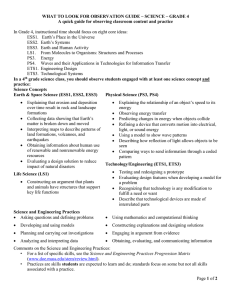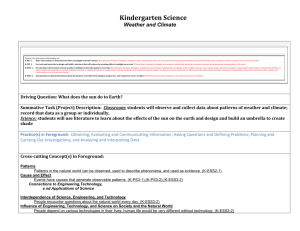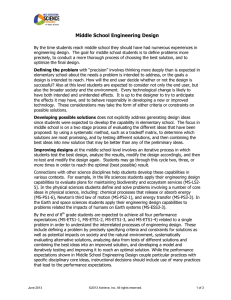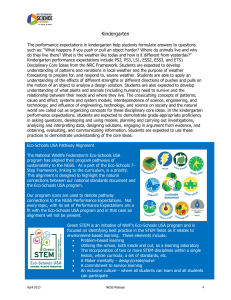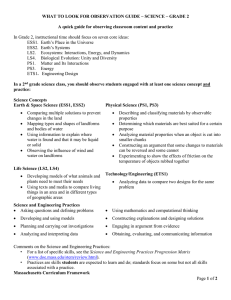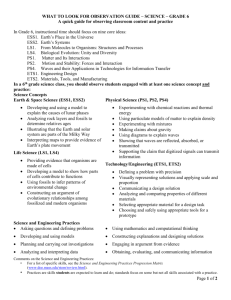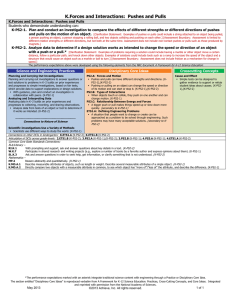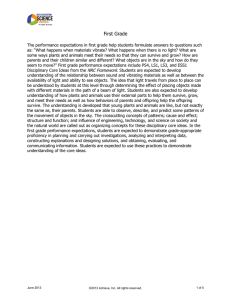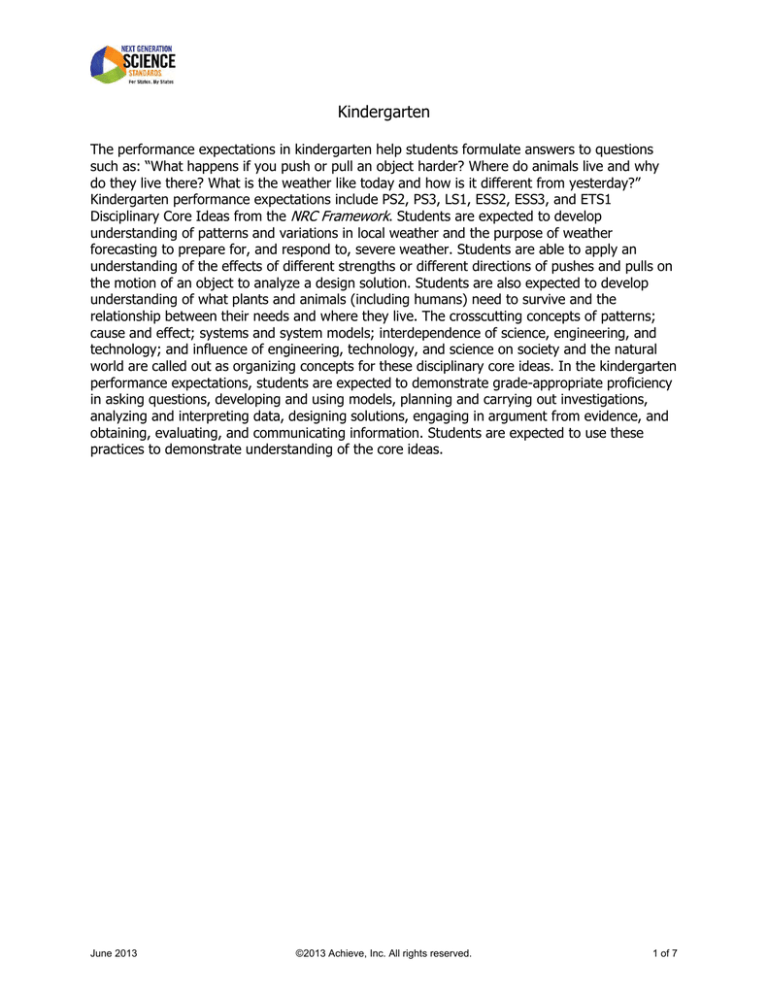
Kindergarten
The performance expectations in kindergarten help students formulate answers to questions
such as: “What happens if you push or pull an object harder? Where do animals live and why
do they live there? What is the weather like today and how is it different from yesterday?”
Kindergarten performance expectations include PS2, PS3, LS1, ESS2, ESS3, and ETS1
Disciplinary Core Ideas from the NRC Framework. Students are expected to develop
understanding of patterns and variations in local weather and the purpose of weather
forecasting to prepare for, and respond to, severe weather. Students are able to apply an
understanding of the effects of different strengths or different directions of pushes and pulls on
the motion of an object to analyze a design solution. Students are also expected to develop
understanding of what plants and animals (including humans) need to survive and the
relationship between their needs and where they live. The crosscutting concepts of patterns;
cause and effect; systems and system models; interdependence of science, engineering, and
technology; and influence of engineering, technology, and science on society and the natural
world are called out as organizing concepts for these disciplinary core ideas. In the kindergarten
performance expectations, students are expected to demonstrate grade-appropriate proficiency
in asking questions, developing and using models, planning and carrying out investigations,
analyzing and interpreting data, designing solutions, engaging in argument from evidence, and
obtaining, evaluating, and communicating information. Students are expected to use these
practices to demonstrate understanding of the core ideas.
June 2013
©2013 Achieve, Inc. All rights reserved.
1 of 7
K-PS2 Motion and Stability: Forces and Interactions
K-PS2 Motion and Stability: Forces and interactions
Students who demonstrate understanding can:
K-PS2-1. Plan and conduct an investigation to compare the effects of different strengths or different directions of pushes
and pulls on the motion of an object. [Clarification Statement: Examples of pushes or pulls could include a string attached to an object being pulled,
a person pushing an object, a person stopping a rolling ball, and two objects colliding and pushing on each other.] [Assessment Boundary: Assessment is limited to
different relative strengths or different directions, but not both at the same time. Assessment does not include non-contact pushes or pulls such as those produced by
magnets.]
K-PS2-2. Analyze data to determine if a design solution works as intended to change the speed or direction of an object
with a push or a pull.* [Clarification Statement: Examples of problems requiring a solution could include having a marble or other object move a certain
distance, follow a particular path, and knock down other objects. Examples of solutions could include tools such as a ramp to increase the speed of the object and a
structure that would cause an object such as a marble or ball to turn.] [Assessment Boundary: Assessment does not include friction as a mechanism for change in
speed.]
The performance expectations above were developed using the following elements from the NRC document A Framework for K-12 Science Education:
Science and Engineering Practices
Planning and Carrying Out Investigations
Planning and carrying out investigations to answer questions or
test solutions to problems in K–2 builds on prior experiences
and progresses to simple investigations, based on fair tests,
which provide data to support explanations or design solutions.
With guidance, plan and conduct an investigation in
collaboration with peers. (K-PS2-1)
Analyzing and Interpreting Data
Analyzing data in K–2 builds on prior experiences and
progresses to collecting, recording, and sharing observations.
Analyze data from tests of an object or tool to determine if
it works as intended. (K-PS2-2)
-----------------------------------------------------
Connections to Nature of Science
Disciplinary Core Ideas
PS2.A: Forces and Motion
Pushes and pulls can have different strengths and directions. (KPS2-1),(K-PS2-2)
Pushing or pulling on an object can change the speed or direction
of its motion and can start or stop it. (K-PS2-1),(K-PS2-2)
PS2.B: Types of Interactions
When objects touch or collide, they push on one another and can
change motion. (K-PS2-1)
PS3.C: Relationship Between Energy and Forces
A bigger push or pull makes things speed up or slow down more
quickly. (secondary to K-PS2-1)
ETS1.A: Defining Engineering Problems
A situation that people want to change or create can be
approached as a problem to be solved through engineering. Such
problems may have many acceptable solutions. (secondary to K-
Crosscutting Concepts
Cause and Effect
Simple tests can be designed to
gather evidence to support or refute
student ideas about causes. (K-PS21),(K-PS2-2)
PS2-2)
Scientific Investigations Use a Variety of Methods
Scientists use different ways to study the world. (K-PS2-1)
Connections to other DCIs in kindergarten: K.ETS1.A (K-PS2-2); K.ETS1.B (K-PS2-2)
Articulation of DCIs across grade-levels: 2.ETS1.B (K-PS2-2); 3.PS2.A (K-PS2-1),(K-PS2-2); 3.PS2.B (K-PS2-1); 4.PS3.A (K-PS2-1); 4.ETS1.A (K-PS2-2)
Common Core State Standards Connections:
ELA/Literacy –
RI.K.1
W.K.7
SL.K.3
With prompting and support, ask and answer questions about key details in a text. (K-PS2-2)
Participate in shared research and writing projects (e.g., explore a number of books by a favorite author and express opinions about them). (K-PS2-1)
Ask and answer questions in order to seek help, get information, or clarify something that is not understood. (K-PS2-2)
MP.2
K.MD.A.1
K.MD.A.2
Reason abstractly and quantitatively. (K-PS2-1)
Describe measurable attributes of objects, such as length or weight. Describe several measurable attributes of a single object. (K-PS2-1)
Directly compare two objects with a measurable attribute in common, to see which object has “more of”/”less of” the attribute, and describe the difference. (K-PS2-1)
Mathematics –
*The performance expectations marked with an asterisk integrate traditional science content with engineering through a Practice or Disciplinary Core Idea.
The section entitled “Disciplinary Core Ideas” is reproduced verbatim from A Framework for K-12 Science Education: Practices, Cross-Cutting Concepts, and Core Ideas. Integrated
and reprinted with permission from the National Academy of Sciences.
June 2013
©2013 Achieve, Inc. All rights reserved.
2 of 7
K-PS3 Energy
K-PS3 Energy
Students who demonstrate understanding can:
K-PS3-1. Make observations to determine the effect of sunlight on Earth’s surface.
[Clarification Statement: Examples of Earth’s surface could
include sand, soil, rocks, and water] [Assessment Boundary: Assessment of temperature is limited to relative measures such as warmer/cooler.]
K-PS3-2.
Use tools and materials to design and build a structure that will reduce the warming effect of sunlight on an area.*
[Clarification Statement: Examples of structures could include umbrellas, canopies, and tents that minimize the warming effect of the sun.]
The performance expectations above were developed using the following elements from the NRC document A Framework for K-12 Science Education:
Science and Engineering Practices
Planning and Carrying Out Investigations
Planning and carrying out investigations to answer questions or test
solutions to problems in K–2 builds on prior experiences and progresses
to simple investigations, based on fair tests, which provide data to
support explanations or design solutions.
Make observations (firsthand or from media) to collect data that can
be used to make comparisons. (K-PS3-1)
Constructing Explanations and Designing Solutions
Constructing explanations and designing solutions in K–2 builds on prior
experiences and progresses to the use of evidence and ideas in
constructing evidence-based accounts of natural phenomena and
designing solutions.
Use tools and materials provided to design and build a device that
solves a specific problem or a solution to a specific problem. (K-PS32)
Disciplinary Core Ideas
Crosscutting Concepts
PS3.B: Conservation of Energy and Energy Transfer
Sunlight warms Earth’s surface. (K-PS3-1),(K-PS3-2)
Cause and Effect
Events have causes that generate
observable patterns. (K-PS3-1),(K-PS3-2)
-----------------------------------------------------------------------
Connections to Nature of Science
Scientific Investigations Use a Variety of Methods
Scientists use different ways to study the world. (K-PS3-1)
Connections to other DCIs in kindergarten: K.ETS1.A (K-PS3-2); K.ETS1.B (K-PS3-2)
Articulation of DCIs across grade-levels: 1.PS4.B (K-PS3-1),(K-PS3-2); 2.ETS1.B (K-PS3-2), 3.ESS2.D (K-PS3-1); 4.ETS1.A (K-PS3-2)
Common Core State Standards Connections:
ELA/Literacy –
W.K.7
Participate in shared research and writing projects (e.g., explore a number of books by a favorite author and express opinions about them). (K-PS3-1),(K-PS3-2)
K.MD.A.2
Directly compare two objects with a measurable attribute in common, to see which object has “more of”/”less of” the attribute, and describe the difference. (K-PS3-1),(KPS3-2)
Mathematics –
*The performance expectations marked with an asterisk integrate traditional science content with engineering through a Practice or Disciplinary Core Idea.
The section entitled “Disciplinary Core Ideas” is reproduced verbatim from A Framework for K-12 Science Education: Practices, Cross-Cutting Concepts, and Core Ideas. Integrated
and reprinted with permission from the National Academy of Sciences.
June 2013
©2013 Achieve, Inc. All rights reserved.
3 of 7
K-LS1 From Molecules to Organisms: Structures and Processes
K-LS1 From Molecules to Organisms: Structures and Processes
Students who demonstrate understanding can:
K-LS1-1. Use observations to describe patterns of what plants and animals (including humans) need to survive.
[Clarification
Statement: Examples of patterns could include that animals need to take in food but plants do not; the different kinds of food needed by different types of animals;
the requirement of plants to have light; and, that all living things need water.]
The performance expectations above were developed using the following elements from the NRC document A Framework for K-12 Science Education:
Science and Engineering Practices
Analyzing and Interpreting Data
Analyzing data in K–2 builds on prior experiences and
progresses to collecting, recording, and sharing observations.
Use observations (firsthand or from media) to describe
patterns in the natural world in order to answer scientific
questions. (K-LS1-1)
Disciplinary Core Ideas
LS1.C: Organization for Matter and Energy Flow in
Organisms
All animals need food in order to live and grow. They obtain
their food from plants or from other animals. Plants need water
and light to live and grow. (K-LS1-1)
Crosscutting Concepts
Patterns
Patterns in the natural and human
designed world can be observed and
used as evidence. (K-LS1-1)
----------------------------------------------------------
Connections to Nature of Science
Scientific Knowledge is Based on Empirical Evidence
Scientists look for patterns and order when making
observations about the world. (K-LS1-1)
Connections to other DCIs in kindergarten: N/A
Articulation of DCIs across grade-levels: 1.LS1.A (K-LS1-1); 2.LS2.A (K-LS1-1); 3.LS2.C (K-LS1-1); 3.LS4.B (K-LS1-1); 5.LS1.C (K-LS1-1); 5.LS2.A (K-LS1-1)
Common Core State Standards Connections:
ELA/Literacy –
W.K.7
Participate in shared research and writing projects (e.g., explore a number of books by a favorite author and express opinions about them). (K-LS1-1)
K.MD.A.2
Directly compare two objects with a measurable attribute in common, to see which object has “more of”/”less of” the attribute, and describe the difference. (K-LS1-1)
Mathematics –
*The performance expectations marked with an asterisk integrate traditional science content with engineering through a Practice or Disciplinary Core Idea.
The section entitled “Disciplinary Core Ideas” is reproduced verbatim from A Framework for K-12 Science Education: Practices, Cross-Cutting Concepts, and Core Ideas. Integrated
and reprinted with permission from the National Academy of Sciences.
June 2013
©2013 Achieve, Inc. All rights reserved.
4 of 7
K-ESS2 Earth’s Systems
K-ESS2 Earth’s Systems
Students who demonstrate understanding can:
K-ESS2-1. Use and share observations of local weather conditions to describe patterns over time.
[Clarification Statement: Examples of
qualitative observations could include descriptions of the weather (such as sunny, cloudy, rainy, and warm); examples of quantitative observations could include
numbers of sunny, windy, and rainy days in a month. Examples of patterns could include that it is usually cooler in the morning than in the afternoon and the number
of sunny days versus cloudy days in different months.] [Assessment Boundary: Assessment of quantitative observations limited to whole numbers and relative
measures such as warmer/cooler.]
K-ESS2-2. Construct an argument supported by evidence for how plants and animals (including humans) can change the
environment to meet their needs. [Clarification Statement: Examples of plants and animals changing their environment could include a squirrel digs in
the ground to hide its food and tree roots can break concrete.]
The performance expectations above were developed using the following elements from the NRC document A Framework for K-12 Science Education:
Science and Engineering Practices
Disciplinary Core Ideas
Crosscutting Concepts
Analyzing and Interpreting Data
Analyzing data in K–2 builds on prior experiences and progresses to
collecting, recording, and sharing observations.
Use observations (firsthand or from media) to describe patterns in
the natural world in order to answer scientific questions. (K-ESS2-1)
Engaging in Argument from Evidence
Engaging in argument from evidence in K–2 builds on prior experiences
and progresses to comparing ideas and representations about the natural
and designed world(s).
Construct an argument with evidence to support a claim. (K-ESS2-2)
ESS2.D: Weather and Climate
Weather is the combination of sunlight, wind, snow or
rain, and temperature in a particular region at a
particular time. People measure these conditions to
describe and record the weather and to notice patterns
over time. (K-ESS2-1)
ESS2.E: Biogeology
Plants and animals can change their environment. (KESS2-2)
ESS3.C: Human Impacts on Earth Systems
Things that people do to live comfortably can affect the
world around them. But they can make choices that
reduce their impacts on the land, water, air, and other
living things. (secondary to K-ESS2-2)
Patterns
Patterns in the natural world can be
observed, used to describe phenomena,
and used as evidence. (K-ESS2-1)
Systems and System Models
Systems in the natural and designed
world have parts that work together.
(K-ESS2-2)
---------------------------------------------------------------------
Connections to Nature of Science
Science Knowledge is Based on Empirical Evidence
Scientists look for patterns and order when making observations
about the world. (K-ESS2-1)
Connections to other DCIs in kindergarten: N/A
Articulation of DCIs across grade-levels: 2.ESS2.A (K-ESS2-1); 3.ESS2.D (K-ESS2-1); 4.ESS2.A (K-ESS2-1); 4.ESS2.E (K-ESS2-2); 5.ESS2.A (K-ESS2-2)
Common Core State Standards Connections:
ELA/Literacy –
RI.K.1
W.K.1
W.K.7
With prompting and support, ask and answer questions about key details in a text. (K-ESS2-2)
Use a combination of drawing, dictating, and writing to compose opinion pieces in which they tell a reader the topic or the name of the book they are writing about and
state an opinion or preference about the topic or book. (K-ESS2-2)
Use a combination of drawing, dictating, and writing to compose informative/explanatory texts in which they name what they are writing about and supply some
information about the topic. (K-ESS2-2)
Participate in shared research and writing projects (e.g., explore a number of books by a favorite author and express opinions about them). (K-ESS2-1)
MP.2
MP.4
K.CC.A
K.MD.A.1
K.MD.B.3
Reason abstractly and quantitatively. (K-ESS2-1)
Model with mathematics. (K-ESS2-1)
Know number names and the count sequence. (K-ESS2-1)
Describe measurable attributes of objects, such as length or weight. Describe several measurable attributes of a single object. (K-ESS2-1)
Classify objects into given categories; count the number of objects in each category and sort the categories by count. (K-ESS2-1)
W.K.2
Mathematics –
*The performance expectations marked with an asterisk integrate traditional science content with engineering through a Practice or Disciplinary Core Idea.
The section entitled “Disciplinary Core Ideas” is reproduced verbatim from A Framework for K-12 Science Education: Practices, Cross-Cutting Concepts, and Core Ideas. Integrated
and reprinted with permission from the National Academy of Sciences.
June 2013
©2013 Achieve, Inc. All rights reserved.
5 of 7
K-ESS3 Earth and Human Activity
K-ESS3 Earth and Human Activity
Students who demonstrate understanding can:
K-ESS3-1. Use a model to represent the relationship between the needs of different plants or animals (including humans)
and the places they live. [Clarification Statement: Examples of relationships could include that deer eat buds and leaves, therefore, they usually live in
forested areas; and, grasses need sunlight so they often grow in meadows. Plants, animals, and their surroundings make up a system.]
K-ESS3-2. Ask questions to obtain information about the purpose of weather forecasting to prepare for, and respond to,
severe weather.* [Clarification Statement: Emphasis is on local forms of severe weather.]
K-ESS3-3. Communicate solutions that will reduce the impact of humans on the land, water, air, and/or other living things
in the local environment.* [Clarification Statement: Examples of human impact on the land could include cutting trees to produce paper and using
resources to produce bottles. Examples of solutions could include reusing paper and recycling cans and bottles.]
The performance expectations above were developed using the following elements from the NRC document A Framework for K-12 Science Education:
Science and Engineering Practices
Disciplinary Core Ideas
Asking Questions and Defining Problems
Asking questions and defining problems in grades K–2 builds
on prior experiences and progresses to simple descriptive
questions that can be tested.
Ask questions based on observations to find more
information about the designed world. (K-ESS3-2)
Developing and Using Models
Modeling in K–2 builds on prior experiences and progresses to
include using and developing models (i.e., diagram, drawing,
physical replica, diorama, dramatization, storyboard) that
represent concrete events or design solutions.
Use a model to represent relationships in the natural
world. (K-ESS3-1)
Obtaining, Evaluating, and Communicating Information
Obtaining, evaluating, and communicating information in K–2
builds on prior experiences and uses observations and texts to
communicate new information.
Read grade-appropriate texts and/or use media to obtain
scientific information to describe patterns in the natural
world. (K-ESS3-2)
Communicate solutions with others in oral and/or written
forms using models and/or drawings that provide detail
about scientific ideas. (K-ESS3-3)
ESS3.A: Natural Resources
Living things need water, air, and resources from the land, and
they live in places that have the things they need. Humans use
natural resources for everything they do. (K-ESS3-1)
ESS3.B: Natural Hazards
Some kinds of severe weather are more likely than others in a
given region. Weather scientists forecast severe weather so that
the communities can prepare for and respond to these events.
(K-ESS3-2)
ESS3.C: Human Impacts on Earth Systems
Things that people do to live comfortably can affect the world
around them. But they can make choices that reduce their
impacts on the land, water, air, and other living things. (K-ESS33)
ETS1.A: Defining and Delimiting an Engineering Problem
Asking questions, making observations, and gathering
information are helpful in thinking about problems. (secondary
to K-ESS3-2)
ETS1.B: Developing Possible Solutions
Designs can be conveyed through sketches, drawings, or
physical models. These representations are useful in
communicating ideas for a problem’s solutions to other people.
(secondary to K-ESS3-3)
Crosscutting Concepts
Cause and Effect
Events have causes that generate
observable patterns. (K-ESS3-2),(KESS3-3)
Systems and System Models
Systems in the natural and designed
world have parts that work together.
(K-ESS3-1)
----------------------------------------
Connections to Engineering, Technology,
and Applications of Science
Interdependence of Science,
Engineering, and Technology
People encounter questions about the
natural world every day. (K-ESS3-2)
Influence of Engineering, Technology,
and Science on Society and the Natural
World
People depend on various technologies
in their lives; human life would be very
different without technology. (K-ESS32)
Connections to other DCIs in kindergarten: K.ETS1.A (K-ESS3-2),(K-ESS3-3)
Articulation of DCIs across grade-levels: 1.LS1.A (K-ESS3-1); 2.ESS1.C (K-ESS3-2); 2.ETS1.B (K-ESS3-3); 3.ESS3.B (K-ESS3-2); 4.ESS3.A (K-ESS3-3); 4.ESS3.B (K-ESS3-2);
5.LS2.A (K-ESS3-1); 5.ESS2.A (K-ESS3-1); 5.ESS3.C (K-ESS3-3)
Common Core State Standards Connections:
ELA/Literacy –
RI.K.1
W.K.2
SL.K.3
SL.K.5
With prompting and support, ask and answer questions about key details in a text. (K-ESS3-2)
Use a combination of drawing, dictating, and writing to compose informative/explanatory texts in which they name what they are writing about and supply some
information about the topic. (K-ESS3-3)
Ask and answer questions in order to seek help, get information, or clarify something that is not understood. (K-ESS3-2)
Add drawings or other visual displays to descriptions as desired to provide additional detail. (K-ESS3-1)
MP.2
MP.4
K.CC
Reason abstractly and quantitatively. (K-ESS3-1)
Model with mathematics. (K-ESS3-1),(K-ESS3-2)
Counting and Cardinality (K-ESS3-1),(K-ESS3-2)
Mathematics –
*The performance expectations marked with an asterisk integrate traditional science content with engineering through a Practice or Disciplinary Core Idea.
The section entitled “Disciplinary Core Ideas” is reproduced verbatim from A Framework for K-12 Science Education: Practices, Cross-Cutting Concepts, and Core Ideas. Integrated
and reprinted with permission from the National Academy of Sciences.
June 2013
©2013 Achieve, Inc. All rights reserved.
6 of 7
K-2-ETS1 Engineering Design
K-2-ETS1
Engineering Design
Students who demonstrate understanding can:
K-2-ETS1-1. Ask questions, make observations, and gather information about a situation people want to change to define a
simple problem that can be solved through the development of a new or improved object or tool.
K-2-ETS1-2. Develop a simple sketch, drawing, or physical model to illustrate how the shape of an object helps it function
as needed to solve a given problem.
K-2-ETS1-3. Analyze data from tests of two objects designed to solve the same problem to compare the strengths and
weaknesses of how each performs.
The performance expectations above were developed using the following elements from the NRC document A Framework for K-12 Science Education:
Science and Engineering Practices
Disciplinary Core Ideas
Crosscutting Concepts
Asking Questions and Defining Problems
Asking questions and defining problems in K–2 builds on prior
experiences and progresses to simple descriptive questions.
Ask questions based on observations to find more
information about the natural and/or designed world(s). (K2-ETS1-1)
Define a simple problem that can be solved through the
development of a new or improved object or tool. (K-2ETS1-1)
Developing and Using Models
ETS1.A: Defining and Delimiting Engineering Problems
A situation that people want to change or create can be approached
as a problem to be solved through engineering. (K-2-ETS1-1)
Asking questions, making observations, and gathering information
are helpful in thinking about problems. (K-2-ETS1-1)
Before beginning to design a solution, it is important to clearly
understand the problem. (K-2-ETS1-1)
ETS1.B: Developing Possible Solutions
Designs can be conveyed through sketches, drawings, or physical
models. These representations are useful in communicating ideas
for a problem’s solutions to other people. (K-2-ETS1-2)
ETS1.C: Optimizing the Design Solution
Because there is always more than one possible solution to a
problem, it is useful to compare and test designs. (K-2-ETS1-3)
Structure and Function
The shape and stability of structures
of natural and designed objects are
related to their function(s). (K-2ETS1-2)
Modeling in K–2 builds on prior experiences and progresses to
include using and developing models (i.e., diagram, drawing,
physical replica, diorama, dramatization, or storyboard) that
represent concrete events or design solutions.
Develop a simple model based on evidence to represent a
proposed object or tool. (K-2-ETS1-2)
Analyzing and Interpreting Data
Analyzing data in K–2 builds on prior experiences and
progresses to collecting, recording, and sharing observations.
Analyze data from tests of an object or tool to determine if
it works as intended. (K-2-ETS1-3)
Connections to K-2-ETS1.A: Defining and Delimiting Engineering Problems include:
Kindergarten: K-PS2-2, K-ESS3-2
Connections to K-2-ETS1.B: Developing Possible Solutions to Problems include:
Kindergarten: K-ESS3-3, First Grade: 1-PS4-4, Second Grade: 2-LS2-2
Connections to K-2-ETS1.C: Optimizing the Design Solution include:
Second Grade: 2-ESS2-1
Articulation of DCIs across grade-bands: 3-5.ETS1.A (K-2-ETS1-1),(K-2-ETS1-2),(K-2-ETS1-3); 3-5.ETS1.B (K-2-ETS1-2),(K-2-ETS1-3); 3-5.ETS1.C (K-2-ETS1-1),(K-2-ETS1-2),( K2-ETS1-3)
Common Core State Standards Connections:
ELA/Literacy –
RI.2.1
W.2.6
W.2.8
SL.2.5
Mathematics –
MP.2
MP.4
MP.5
2.MD.D.10
Ask and answer such questions as who, what, where, when, why, and how to demonstrate understanding of key details in a text. (K-2-ETS1-1)
With guidance and support from adults, use a variety of digital tools to produce and publish writing, including in collaboration with peers. (K-2-ETS1-1),(K-2-ETS1-3)
Recall information from experiences or gather information from provided sources to answer a question. (K-2-ETS1-1),(K-2-ETS1-3)
Create audio recordings of stories or poems; add drawings or other visual displays to stories or recounts of experiences when appropriate to clarify ideas, thoughts, and
feelings. (K-2-ETS1-2)
Reason abstractly and quantitatively. (K-2-ETS1-1),(K-2-ETS1-3)
Model with mathematics. (K-2-ETS1-1),(K-2-ETS1-3)
Use appropriate tools strategically. (K-2-ETS1-1),(K-2-ETS1-3)
Draw a picture graph and a bar graph (with single-unit scale) to represent a data set with up to four categories. Solve simple put-together, take-apart, and compare
problems using information presented in a bar graph. (K-2-ETS1-1),(K-2-ETS1-3)
The section entitled “Disciplinary Core Ideas” is reproduced verbatim from A Framework for K-12 Science Education: Practices, Cross-Cutting Concepts, and Core Ideas. Integrated
and reprinted with permission from the National Academy of Sciences.
June 2013
©2013 Achieve, Inc. All rights reserved.
7 of 7

